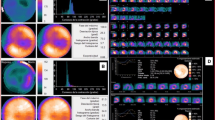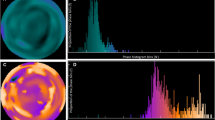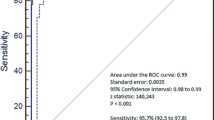Abstract
This study aimed to assess the diagnostic efficacy of left ventricular synchrony (LVS) for detecting coronary artery disease (CAD). We explored whether the LVS index derived from phase analysis of D-SPECT provides superior diagnostic value compared to conventional perfusion analysis in identifying obstructive CAD. Patients with suspected or confirmed CAD underwent drug-stress/rest gated D-SPECT myocardial perfusion imaging (MPI) and coronary angiography (CAG). A 50% stenosis was set as the threshold for obstructive CAD. 110 participants were enrolled in this analysis. There were significant differences in phase standard deviation (PSD), phase histogram bandwidth (PHB) and entropy among the four groups. Patients without cardiac disease and those with mild-moderate stenosis exhibited no noticeable contraction asynchrony. However, LVS indices demonstrated a gradual increase with the progression of coronary stenosis when compared to NC (P < 0.001). Obstructive CAD was identified in 43 out of 110 participants (39%). Optimal cutoff values for diagnosing obstructive CAD during stress were determined as 7.6° for PSD, 24° for PHB, and 37% for entropy, respectively. Notably, PSD, PHB, and entropy indices exhibited higher sensitivity compared to MPI. The integration of the stress-induced LVS indices into routine MPI analysis resulted in a significantly greater area under the curve (AUC), leading to improved diagnostic performance and enhanced differential capacity. Stress-induced LVS indices increase with the severity of coronary artery stenosis by D-SPECT phase analysis. Further, the indices-derived phase analysis exhibits superior sensitivity and discriminatory ability compared to MPI in detecting obstructive CAD.
Graphical abstract




Similar content being viewed by others
Data availability
All data generated or analyzed during this study are included in this article or its online supplementary material files. Further enquiries can be directed to the corresponding author.
Abbreviations
- CAD:
-
Coronary artery disease
- CZT:
-
Cadmium zinc telluride
- LVS:
-
Left ventricular synchrony
- SSS:
-
Summed stress score
- MPI:
-
Myocardial perfusion imaging
- SDS:
-
Summed difference score
- CAG:
-
Coronary angiography
- ROI:
-
Region of interest
- PSD:
-
Phase standard deviation
- AUC:
-
Area under the curve
- PHB:
-
Phase histogram bandwidth
- LVF:
-
Left ventricular function
- SPECT:
-
Single photon emission computed tomography
- ECG:
-
Electrocardiogram
References
GBD (2013) Mortality and causes of death collaborators (2015) global, regional, and national age-sex specific all-cause and cause-specific mortality for 240 causes of death, 1990–2013: a systematic analysis for the global burden of disease study 2013. Lancet 385(9963):117–171. https://doi.org/10.1016/S0140-6736(14)61682-2
Maron DJ, Hochman JS, Reynolds HR, Bangalore S, O’Brien SM, Boden WE et al (2020) Initial invasive or conservative strategy for stable coronary disease. N Engl J Med 382(15):1395–1407. https://doi.org/10.1056/NEJMoa1915922
Mansournia MA, Holakouie-Naieni K, Fahimfar N, Almasi-Hashiani A, Cheraghi Z, Ayubi E et al (2017) Risk of coronary heart events based on rose angina questionnaire and ecg besides diabetes and other metabolic risk factors: results of a 10-year follow-up in tehran lipid and glucose study. Int J Endocrinol Metab 15(2):e42713. https://doi.org/10.5812/ijem.42713
Nash K, Hafeez A, Hou S (2002) Hospital-acquired renal insufficiency. Am J Kidney Dis 39(5):930–936. https://doi.org/10.1053/ajkd.2002.32766
Piccolo R, Giustino G, Mehran R, Windecker S (2015) Stable coronary artery disease: revascularisation and invasive strategies. Lancet 386(9994):702–713. https://doi.org/10.1016/S0140-6736(15)61220-X
Ananthasubramaniam K, Arumugam P (2022) Can we “REFINE” the art of predicting ischemia on SPECT myocardial perfusion imaging? J Nucl Cardiol 29(6):3233–3235. https://doi.org/10.1007/s12350-021-02867-5
Hess PL, Shaw LK, Fudim M, Iskandrian AE, Borges-Neto S (2017) The prognostic value of mechanical left ventricular dyssynchrony defined by phase analysis from gated single-photon emission computed tomography myocardial perfusion imaging among patients with coronary heart disease. J Nucl Cardiol 24(2):482–490
Trimble MA, Velazquez EJ, Adams GL, Honeycutt EF, Pagnanelli RA, Barnhart HX et al (2008) Repeatability and reproducibility of phase analysis of gated single-photon emission computed tomography myocardial perfusion imaging used to quantify cardiac dyssynchrony. Nucl Med Commun 29(4):374–381. https://doi.org/10.1097/MNM.0b013e3282f81380
Lin WL, Wang SY, Shiau YC, Wu YW (2020) The clinical usefulness of phase analysis in detecting coronary artery disease using dipyridamole thallium-201-gated myocardial perfusion imaging with a cadmium-zinc-telluride camera. J Nucl Cardiol 27(1):241–250. https://doi.org/10.1007/s12350-018-1417-2
Chen CC, Shen TY, Chang MC, Hung GU, Chen WC, Kao CH et al (2012) Stress-induced myocardial ischemia is associated with early post-stress left ventricular mechanical dyssynchrony as assessed by phase analysis of 201Tl gated SPECT myocardial perfusion imaging. Eur J Nucl Med Mol Imaging 39(12):1904–1909. https://doi.org/10.1007/s00259-012-2208-7
Hida S, Chikamori T, Tanaka H, Igarashi Y, Shiba C, Usui Y et al (2012) Diagnostic value of left ventricular dyssynchrony after exercise and at rest in the detection of multivessel coronary artery disease on single-photon emission computed tomography. Circ J 76(8):1942–1952. https://doi.org/10.1253/circj.cj-11-1392
Huang WS, Huang CH, Lee CL, Chen CP, Hung GU, Chen J (2014) Relation of early post-stress left ventricular dyssynchrony and the extent of angiographic coronary artery disease. J Nucl Cardiol 21(6):1048–1056. https://doi.org/10.1007/s12350-014-9980-7
Gimelli A, Liga R, Giorgetti A, Favilli B, Pasanisi EM, Marzullo P (2016) Determinants of left ventricular mechanical dyssynchrony in patients submitted to myocardial perfusion imaging: a cardiac CZT study. J Nucl Cardiol 23(4):728–736. https://doi.org/10.1007/s12350-015-0247-8
Cantoni V, Green R, Acampa W, Zampella E, Assante R, Nappi C et al (2021) Diagnostic performance of myocardial perfusion imaging with conventional and CZT single-photon emission computed tomography in detecting coronary artery disease: a meta-analysis. J Nucl Cardiol 28(2):698–715. https://doi.org/10.1007/s12350-019-01747-3
Allie R, Hutton BF, Prvulovich E, Bomanji J, Michopoulou S, Ben-Haim S (2016) Pitfalls and artifacts using the D-SPECT dedicated cardiac camera. J Nucl Cardiol. 23(2):301–10
Henzlova MJ, Duvall L (2022) Is the CZT technology the future of nuclear cardiology? J Nucl Cardiol 29(2):737–740. https://doi.org/10.1007/s12350-020-02399-4
Dorbala S, Ananthasubramaniam K, Armstrong IS, Chareonthaitawee P, DePuey EG, Einstein AJ et al (2018) Single photon emission computed tomography (SPECT) myocardial perfusion imaging guidelines: instrumentation, acquisition, processing, and interpretation. J Nucl Cardiol 25(5):1784–1846. https://doi.org/10.1007/s12350-018-1283-y
Sharir T, Germano G, Kang X, Lewin HC, Miranda R, Cohen I, Agafitei RD, Friedman JD, Berman DS (2001) Prediction of myocardial infarction versus cardiac death by gated myocardial perfusion SPECT: risk stratification by the amount of stress-induced ischemia and the poststress ejection fraction. J Nucl Med off Publ soc Nucl Med 42(6):831–837
Wang J, Li S, Chen W, Chen Y, Pang Z, Li J (2021) Diagnostic efficiency of quantification of myocardial blood flow and coronary flow reserve with CZT dynamic SPECT imaging for patients with suspected coronary artery disease: a comparative study with traditional semi-quantitative evaluation. Cardiovasc Diagn Ther 11(1):56–6
Kwon O, Hwang HJ, Koo HJ, Yang DH, Kang HJ, Kim JA, Moon DH, Kim HS, Kang JW, Kim YH (2019) Ischemic burden assessment of myocardial perfusion CT, compared with SPECT using semi-quantitative and quantitative approaches. Int J Cardiol 278:287–294. https://doi.org/10.1016/j.ijcard.2018.12.046
Austen WG, Edwards JE, Frye RL, Gensini GG, Gott VL, Griffith LS et al (1975) A reporting system on patients evaluated for coronary artery disease. report of the ad hoc committee for grading of coronary artery disease, council on cardiovascular surgery. Am Heart Assoc. Circ 51:5–40
Chen J, Garcia EV, Bax JJ, Iskandrian AE, Borges-Neto S, Soman P (2011) SPECT myocardial perfusion imaging for the assessment of left ventricular mechanical dyssynchrony. J Nucl Cardiol 18:685–694. https://doi.org/10.1007/s12350-011-9392-x
AlJaroudi W, Alraies MC, Menon V, Brunken RC, Cerqueira MD, Jaber WA (2012) Predictors and incremental prognostic value of left ventricular mechanical dyssynchrony response during stress-gated positron emission tomography in patients with ischemic cardiomyopathy. J Nucl Cardiol 19(5):958–969. https://doi.org/10.1007/s12350-012-9592-z
Agostini D, Marie PY, Ben-Haim S, Rouzet F, Songy B, Giordano A et al (2016) Cardiovascular committee of the European association of nuclear medicine (EANM) performance of cardiac cadmium-zinc-telluride gamma camera imaging in coronary artery disease: a review from the cardiovascular committee of the European association of nuclear medicine (EANM). Eur J Nucl Med Mol Imaging 43(13):2423–2432. https://doi.org/10.1007/s00259-016-3467-5
Alexánderson-Rosas E, Hernández-Sandoval S (2022) Gated SPECT beyond myocardial perfusion: assessment of mechanical left ventricular synchrony. J Nucl Cardiol 29(3):975–977. https://doi.org/10.1007/s12350-020-02518-1
Singh H, Patel CD, Sharma P, Naik N, Singh S, Narang R (2015) Does perfusion pattern influence stress-induced changes in left ventricular mechanical dyssynchrony on thallium-201-gated SPECT myocardial perfusion imaging? J Nucl Cardiol 22(1):36–43. https://doi.org/10.1007/s12350-014-9979-0
Zhou Y, Li D, Feng J, Yuan D, Patel Z, Cao K, Chen J (2013) Left Ventricular Dyssynchrony Parameters Measured by Phase Analysis of Post-stress and Resting Gated SPECT Myocardial Perfusion Imaging. World J Nucl Med 12(1):3–7. https://doi.org/10.4103/1450-1147.113931
AlJaroudi W, Jaber WA, Cerqueira MD (2012) Effect of tracer dose on left ventricular mechanical dyssynchrony indices by phase analysis of gated single photon emission computed tomography myocardial perfusion imaging. J Nucl Cardiol 19(1):63–72. https://doi.org/10.1007/s12350-011-9463-z
Henneman MM, Chen J, Dibbets-Schneider P, Stokkel MP, Bleeker GB, Ypenburg C et al (2007) Can LV dyssynchrony as assessed with phase analysis on gated myocardial perfusion SPECT predict response to CRT? J Nucl Med 48(7):1104–1111. https://doi.org/10.2967/jnumed.107.039925
Chen J, Garcia EV, Folks RD, Cooke CD, Faber TL, Tauxe EL et al (2005) Onset of left ventricular mechanical contraction as determined by phase analysis of ECG-gated myocardial perfusion SPECT imaging: development of a diagnostic tool for assessment of cardiac mechanical dyssynchrony. J Nucl Cardiol 12:687–695. https://doi.org/10.1016/j.nuclcard.2005.06.088
Hämäläinen H, Hedman M, Laitinen T, Hedman A, Kivelä A, Laitinen T (2018) Reference values for left ventricular systolic synchrony according to phase analysis of ECG-gated myocardial perfusion SPECT. Clin Physiol Funct Imaging 38:38–45. https://doi.org/10.1111/cpf.12379
Maddahi J, Agostini D, Bateman TM, Bax JJ, Beanlands RSB, Berman DS, Dorbala S, Garcia EV, Feldman J, Heller GV, Knuuti JM, Martinez-Clark P, Pelletier-Galarneau M, Shepple B, Tamaki N, Tranquart F, Udelson JE (2023) Flurpiridaz F-18 PET myocardial perfusion imaging in patients with suspected coronary artery disease. J Am Coll Cardiol 82(16):1598–1610. https://doi.org/10.1016/j.jacc.2023.08.016
Acknowledgements
We would like to express our gratitude to all researchers who participated in the study and the staff of PET/CT Center and Department of Cardiology at Gansu Provincial Hospital for their selfless help and valuable assistance. Thanks to the experts who provided professional advice.
Funding
This study was supported by the Natural Science Foundation of Gansu Province (21JR7RA633, 22JR5RA666).
Author information
Authors and Affiliations
Contributions
**nhua Ding, Lanlan Cui, Fu Zhang and Jiancang Cao were involved in the design of this study and contributed to the writing of manuscript. **nhua Ding, Lanlan Cui, Mingjia Ding performed clinical data collection and image interpretation. **nhua Ding, Jianfeng Li and Haiyong Wang performed data analysis. **nhua Ding wrote the first draft of the manuscript. Fu Zhang and Haijun Wang provided critical revisions to the manuscript for important content. The authors of this paper do not have any commercial associations that might pose a conflict of interest in connection with this manuscript.
Corresponding authors
Ethics declarations
Conflict of interest
All authors declare that they have no financial interests or potential conflicts of interest.
Ethical approval
The study conformed to the Declaration of Helsinki. The study was approved by Gansu Provincial Hospital Medical Ethics Committee (Batch number: 2023–394). All subjects provided signed informed consent.
Consent to participate
Inform written consent was obtained from each subject included in this study.
Additional information
Publisher's Note
Springer Nature remains neutral with regard to jurisdictional claims in published maps and institutional affiliations.
Supplementary Information
Below is the link to the electronic supplementary material.
Rights and permissions
Springer Nature or its licensor (e.g. a society or other partner) holds exclusive rights to this article under a publishing agreement with the author(s) or other rightsholder(s); author self-archiving of the accepted manuscript version of this article is solely governed by the terms of such publishing agreement and applicable law.
About this article
Cite this article
Ding, X., Cui, L., Li, J. et al. Assessing the diagnostic value of left ventricular synchrony indices derived from phase analysis by D-SPECT in identifying obstructive coronary artery disease. Int J Cardiovasc Imaging (2024). https://doi.org/10.1007/s10554-024-03182-z
Received:
Accepted:
Published:
DOI: https://doi.org/10.1007/s10554-024-03182-z




